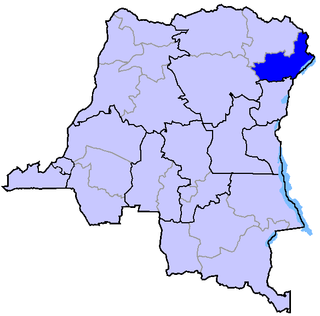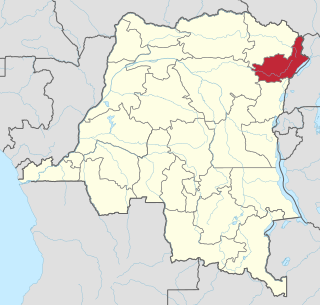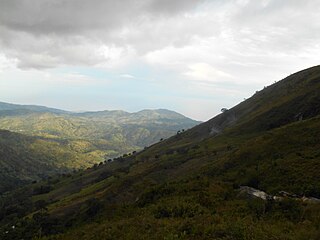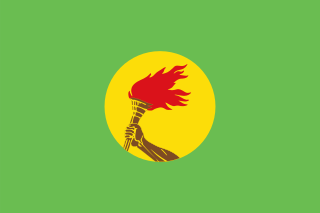Related Research Articles
The earliest known human settlements in what is now the Democratic Republic of the Congo have been dated back to the Middle Stone Age, approximately 90,000 years ago. The first real states, such as the Kongo, the Lunda, the Luba and Kuba, appeared south of the equatorial forest on the savannah from the 14th century onwards.

The United Nations Organization Stabilization Mission in the Democratic Republic of the Congo or MONUSCO, an acronym based on its French name Mission de l'Organisation des Nations Unies pour la stabilisation en République démocratique du Congo, is a United Nations peacekeeping force in the Democratic Republic of the Congo (DRC) which was established by the United Nations Security Council in resolutions 1279 (1999) and 1291 (2000) to monitor the peace process of the Second Congo War, though much of its focus subsequently turned to the Ituri conflict, the Kivu conflict and the Dongo conflict. The mission was known as the United Nations Mission in the Democratic Republic of Congo or MONUC, an acronym of its French name Mission de l'Organisation des Nations Unies en République démocratique du Congo, until 2010.

The Nationalist and Integrationist Front is a rebel group active in the Ituri conflict in Ituri, Democratic Republic of the Congo, associated with the Lendu ethnic group. The FNI has fought against ethnic Hema and is blamed for the ambush and murder of nine United Nations peacekeepers near the town of Kafe in February 2005. FNI political leader Floribert Ndjabu was arrested by Congolese authorities, while military head Etienne Lona turned himself in.

The Ituri conflict is an ongoing low intensity asymmetrical conflict between the agriculturalist Lendu and pastoralist Hema ethnic groups in the Ituri region of the north-eastern Democratic Republic of the Congo (DRC). While the two groups had fought since as early as 1972, the name 'Ituri conflict' refers to the period of intense violence between 1999 and 2003. Armed conflict continues to the present day.

Operation Artemis, formally European Union Force Democratic Republic of the Congo (EUFOR), was a short-term European Union-led UN-authorised military mission to the Democratic Republic of the Congo during the Ituri conflict. ARTEMIS is considered the first military operation led by the EU, the first autonomous EU operation, the first rapid response mission of the EU, first operation outside Europe, first operation applying the principle of the framework nation and first example of "relay operation", conducted in cooperation between the EU and the United Nations. The deployment of EUFOR troops quickly decreased the conflict's intensity. It marked the first autonomous EU military mission outside Europe and an important milestone in development of the European Security and Defence Policy.

The Front for Patriotic Resistance in Ituri is a Bunia-based armed militia and political party primarily active in the south of the Ituri Province of northeastern Democratic Republic of the Congo.

The Peacekeepers is a 2005 documentary film directed by Paul Cowan, following the United Nations mission in the Democratic Republic of the Congo in the Democratic Republic of Congo between 2002 and 2004. The film portrays the attempts of UN Peacekeepers to avert a crisis similar to Rwanda in 1994. The film mixes footage from the actual conflict with that of UN officials behind the lines, to give a comprehensive portrayal of the conflict.

The Allied Democratic Forces insurgency is an ongoing conflict waged by the Allied Democratic Forces in Uganda and the Democratic Republic of the Congo, against the governments of those two countries and the MONUSCO. The insurgency began in 1996, intensifying in 2013, resulting in hundreds of deaths. The ADF is known to currently control a number of hidden camps which are home to about 2,000 people; in these camps, the ADF operates as a proto-state with "an internal security service, a prison, health clinics, and an orphanage" as well as schools for boys and girls.
The 2020 Democratic Republic of the Congo attacks were a series of attacks which took place in 2020. The attacks were mostly carried out by the Allied Democratic Forces (ADF), a radical Islamist rebel group and the Cooperative for the Development of Congo (CODECO), an agricultural and religious group made up of ethnic Lendu people. The attacks left at least 1,316 people dead and 132 injured.
Md. Muhsin Alam, ndc, psc, is a Brigadier General in the Bangladesh Army. He was the principal of BKSP in 2012 and served there for two years. He also served as Colonel GS and Deputy Director General of DGFI. Brigadier General Md. Muhsin Alam, ndc, psc, commanded two infantry battalions of the Bangladesh Army. He also served as the Brigade Commander of an Infantry Brigade. The Brigadier was the pioneer Brigade Commander of the only Para Commando Brigade of the Bangladesh Army. In 2019, on behalf of, the Para Commando Brigade, Brigadier General Muhsin received the raising flag from the Prime Minister of Bangladesh, Sheikh Hasina. This entitles him to be a flag officer. He served at DRC as the Northern Sector Commander of MONUSCO.

CODECO is a loose association of various Lendu militia groups operating within the Democratic Republic of the Congo. The name is an abbreviation of the group's lesser-known full name, the Cooperative for Development of the Congo, sometimes also styled the Congo Economic Development Cooperative.
Attacks were carried out by various armed groups in the Democratic Republic of the Congo in 2021 and 2022. The attacks have killed 629 and injured 321. At least 82 perpetrators were also killed and one injured in these attacks.

Djugu territory is a district of Ituri, Democratic Republic of the Congo. Its capital is also named Djugu.
On 2 February 2022, over 60 civilians from the Hema ethnic group were killed in a massacre in Djugu territory, Ituri Province, Democratic Republic of the Congo.
Events of the year 2022 in the Democratic Republic of the Congo.

Between January 24 and 26, 2023, M23 rebels and Armed Forces of the Democratic Republic of the Congo (FARDC) soldiers fought over the city of Kitshanga. The battle was part of the renewed M23 offensive, and ended on January 26 with M23 forces capturing the city. Civilians accused both M23 and FARDC-aligned militias of war crimes during and after the battle.
On the night between May 16 and 17, 2020, militants from the Lendu CODECO killed twenty-two civilians in the Hema village of Ndjala, in Ituri Province, Democratic Republic of the Congo.

Zaïre-FPAC is a militant group operating in the Democratic Republic of the Congo. The group was founded in opposition to CODECO in 2020.
On October 24, 2020, militants from CODECO-ALC attacked Congolese and MONUSCO forces in the town of Dele, Ituri Province, Democratic Republic of the Congo. In response, Congolese forces launched an offensive against CODECO-ALC, capturing several towns from the group and killing its leader Mountain Wolf.
References
- 1 2 3 4 AFP, Staff Writer With (2023-01-20). "DRC Militia Kills 7, Sparks Backlash Against UN Peacekeepers". The Defense Post. Retrieved 2024-01-17.
- ↑ "DR Congo emergency". UNHCR US. Retrieved 2024-01-17.
- 1 2 3 "Dozens of bodies found in mass graves in DR Congo". Al Jazeera. Retrieved 2024-01-17.
- ↑ "RDC-Ituri: Le groupe Zaïre/FPAC se transforme de plus en plus en un groupe armé organisé, avec un réseau de trafic d'armes en provenance d'Ouganda". Actualite.cd (in French). 2023-01-03. Retrieved 2024-01-17.
- 1 2 3 "Mass graves found in eastern DR Congo: UN". www.aa.com.tr. Retrieved 2024-01-17.
- 1 2 "UN peacekeepers find mass graves in eastern Congo". Reuters. January 19, 2023. Retrieved January 17, 2024.
- ↑ Serwat, Ladd (2023-02-03). "Regional Overview: Africa | January 2023". ACLED. Retrieved 2024-01-17.
- 1 2 "Est de la RDC: une manifestation contre la force régionale violemment réprimée". Actualite.cd (in French). 2023-01-18. Retrieved 2024-01-17.